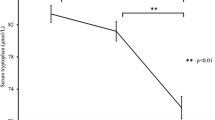Abstract
This study investigated the effect of the serotonin receptor antagonist pizotifen on endurance performance during treadmill exercise in humans. Eight healthy men exercised to exhaustion on a treadmill at an intensity corresponding to 70% of their maximal oxygen uptake (\(\dot VO_{2\max } \)). Pizotifen was administered orally in a 1-mg dose 5 h before the start of exercise. The study was double blind, using a randomized, placebo-controlled crossover design. Oxygen uptake, heart rate, and ratings of perceived exertion were measured and blood samples taken for determination of concentrations of lactate, glucose, amino acids, ammonia, and haematocrit. Measurements were made at intervals of 30 min during the run and at exhaustion. There was no significant difference between the placebo and the pizotifen trials for any of the variables except for the plasma free-tryptophane: branched chain amino acid ratio which was somewhat lower after pizotifen at postexercise. Pizotifen did not increase exercise time to exhaustion, which was even shorter after pizotifen than after placebo in seven out of the eight subjects; the difference between pizotifen and placebo did not reach the level of statistical significance [109.4 (SD 6.7) min after pizotifen versus 119.8 (SD 12.5) min after placebo]. The results do not support the hypothesis that there is a central component to fatigue which is mediated by the serotoninergic neurones.
Similar content being viewed by others
References
Asmussen E (1979) Muscle fatigue. Med Sci Sports 11:313–321
Bailey SP, Davis JM, Ahlborn EN (1992) Effect of increased brain serotonergic activity on endurance performance in the rat. Acta Physiol Scand 145:75–76
Bailey SP, Davis JM, Ahlborn EN (1993a) Neuroendocrine and substrate responses to altered brain 5-HT activity during prolonged exercise to fatigue. J Appl Physiol 74:3006–3012
Bailey SP, Davis JM, Ahlborn EN (1993b) Serotonergic agonists and antagonists affect endurance performance in the rat. Int J Sports Med 14:330–333
Blomstrand E, Celsing F, Newsholme EA (1988) Changes in plasma concentrations of aromatic and branched-chain amino acids during sustained exercise in man and their possible role in fatigue. Acta Physiol Scand 133:115–121
Borg GAV (1970) Perceived exertion as an indicator of somatic stress. Scand J Rehab Red 2:92–98
Elghozi JL, Laude D, Duprat P, Mignot E (1984) Pizotifen increases 5-HIAA urinary excretion in male healthy volunteers. Eur J Clin Pharmacol 27:191–196
Hoyer D, Clarke DE, Fozard JR, Hartig PR, Martin GR, Mylecharane EJ, Saxena PR, Humphrey PPA (1994) International Union of Pharmacology classification of receptors for 5-hydroxytryptamine (serotonin). Pharmacol Rev 46:157–203
Jakeman PM, Hawthorne JE, Maxwell SRJ, Kendall MJ, Holder G (1994) Evidence for downregulation of hypothalamic 5-hydroxytryptamine receptor function in endurance-trained athletes. Exp Physiol 79:461–464
Newsholme EA, Blomstrand E, Ekblom B (1992) Physical and mental fatigue: metabolic mechanisms and importance of plasma amino acids. Br Med Bull 48:477–495
Reynolds JEF (1993) Pizotifen, Martindale the extra pharmacopeia, 30th edn. Pharmaceutical Press, London, p 416
Soares J, Naffah-Mazzacoratti MG, Cavalheiro EA (1994) Increased serotonin levels in physically trained men. Braz J Med Biol Res 27:1635–1638
Speight TM, Avery GS (1972) Pizotifen (BC-105): a review of its pharmacological properties and its therapeutic efficacy in vascular headaches. Drugs 3:159–203
Watson S, Abbott A (1992) Receptor nomenclature supplement Trends Pharmacol Sci [Suppl]:1–36
Wilson WM, Maughan RJ (1992) Evidence for a possible role of 5-hydroxytryptamine in the genesis of fatigue in man: administration of paroxetine, a 5-HT re-uptake inhibitor, reduces the capacity to perform prolonged exercise. Exp Physiol 77:921–924
Author information
Authors and Affiliations
Rights and permissions
About this article
Cite this article
Pannier, J.L., Bouckaert, J.J. & Lefebvre, R.A. The antiserotonin agent pizotifen does not increase endurance performance in humans. Eur J Appl Physiol 72, 175–178 (1995). https://doi.org/10.1007/BF00964134
Accepted:
Issue Date:
DOI: https://doi.org/10.1007/BF00964134




